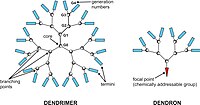
Photo from wikipedia
Cationic dendrimers are intriguing materials that can be used as antibacterial materials; however, they display significant cytotoxicity towards diverse cell lines at high generations or high doses, which limits their… Click to show full abstract
Cationic dendrimers are intriguing materials that can be used as antibacterial materials; however, they display significant cytotoxicity towards diverse cell lines at high generations or high doses, which limits their applications in biomedical fields. In order to decrease the cytotoxicity, a series of biocompatible hybrid hydrogels based on cationic dendrimers and carboxylated cellulose nanofibrils were easily synthesized by non-covalent self-assembly under physiological conditions without external stimuli. The cationic dendrimers from generation 2 (G2) to generation 4 (G4) based on trimethylolpronane (TMP) and 2,2-bis (methylol)propionic acid (bis-MPA) were synthesized through fluoride promoted esterification chemistry (FPE chemistry). FTIR was used to show the presence of the cationic dendrimers within the hybrid hydrogels, and the distribution of the cationic dendrimers was even verified using elemental analysis of nitrogen content. The hybrid hydrogels formed from G3 and G4 showed 100% killing efficiency towards Escherichia coli (E. coli), Staphylococcus aureus (S. aureus) and Pseudomonas aeruginosa (P. aeruginosa) with bacterial concentrations ranging from 105 CFU/mL to 107 CFU/mL. Remarkably, the hybrid hydrogels also showed good biocompatibility most probably due to the incorporation of the biocompatible CNFs that slowed down the release of the cationic dendrimers from the hybrid hydrogels, hence showing great promise as an antibacterial material for biomedical applications.
Journal Title: Pharmaceutics
Year Published: 2020
Link to full text (if available)
Share on Social Media: Sign Up to like & get
recommendations!